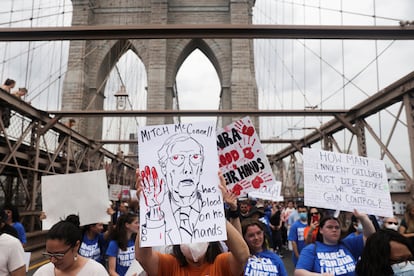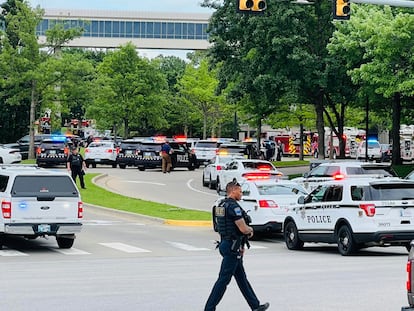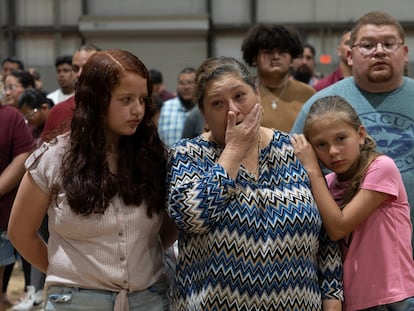Marches against gun violence in the US: “We just want to live through high school”
The March for Our Lives group brings thousands to the streets in more than 400 cities across the country, demanding an end to mass shootings with the implementation of “common sense” gun laws

March for Our Lives, the pro-gun control group created in wake of the 2018 Florida high school shooting, has organized 450 rallies across the country this weekend, in cities such as Washington, New York, Chicago and Los Angeles. Although weather forecasts have hampered plans, thousands took to the streets in Washington. The majority of US public opinion supports the group’s objective for toughening weapon legislation, but above all it shares consternation over recent events in Buffalo (New York) and Uvalde (Texas), just a couple of examples in what is becoming a daily blood bath across the country.
Activist Fred Guttenberg lost his daughter Jamie, a 14-year-old who had a passion for dancing, in the Parkland, Florida shooting on Valentine’s Day 2018, when 19-year-old Nikolas Cruz killed 17 high school students. The tragedy sparked a student movement that brought together 200,000 people in Washington the following month to demonstrate under the slogan March for our lives. The shock wave of this protest reverberated after the latest mass shootings, in an elementary school in Uvalde where 19 children and two teachers were murdered on May 26, and in a supermarket in Buffalo, where 10 African Americans were killed just 12 days prior.
Guttenberg was determined not to miss this rally despite the bleak, rainy morning that greeted protestors. This time he was hopeful for political reaction. “This week the House of Representatives passed a bipartisan gun control bill around three ideas: red flag laws, background checks on buyers, and a review of the legal age to acquire weapons. We only need 10 senators in favor, and I think we are close,” he told the crowds at the foot of the Washington Monument. “Those changes will not be enough, but at least it’s a starting point. We will clear up any doubts between this week and next”.
The highlight of Saturday’s protest in Washington was a rally in which several groups were able to voice their opinions: activists, relatives of the Buffalo shooting victims, survivors of massacres in schools and institutes, and Cori Bush, the Democratic congresswoman for Missouri. The protesters carried banners with provoking messages: “Let’s make supermarkets safe places,” one read. “11-year-olds should be playing outside, not playing dead to save their lives,” read another. “We just want to live through high school,” stated a third.
Young people, wearing blue T-shirts distributed by the organization, represented the bulk of attendees. There were people from further afield too, such as Newtown (Connecticut), a town that became part of the US horror show in 2012, with the massacre at Sandy Hook Elementary School. Jake Schummer, then eight years old, lost two friends, Noah Ponzer and Ben Wheeler, who were among the 20 children and six adults killed by 20-year-old Adam Lanza. “The memory of that tragedy is still very much alive in Newtown a decade later,” Schummer recounted.
Teachers were identifiable by their orange clothes. Robin Gopin and Peter Lynch, educators at the largest school in Maryland, Montgomery Blair High School (Silver Spring), with 3,200 students, regretted that their students, ages nine to 12, have been accustomed to shooting drills “since the third grade.” The last real one was at the beginning of this course, when they were locked up for hours due to a stabbing, without knowing what was really going on.
“It’s sad to see,” said Lynch, “how generation after generation starts political activism to protest their defenselessness against weapons and that nothing happens.” When asked what he thinks of the measure proposed by the Republicans to arm teachers to prevent violence in schools, Gopin answers bluntly: “If that happens, I will resign. It would be extremely dangerous to be given weapons because there are very confusing situations in the day-to-day life of a teacher, and I could not bear that responsibility”.
March for Our Lives emerged from its apparent apathy on May 14, when an 18-year-old white supremacist murdered a dozen people, mostly African Americans, in a Buffalo supermarket. Their activism exposed the political system’s apparent indifference in the face of armed violence, which they described as a failure: “Our country should have done everything in its power much earlier to prevent weapons from falling into the wrong hands. Instead, the cult of guns in the US continues to fuel this white supremacist violence,” the group tweeted on that bloody Saturday in Buffalo.
On Thursday, coinciding with another shootout, the House of Representatives approved, (with the Republican opposition voting against it), a red flag bill, like the one theoretically in place in New York State, which allows legally purchased weapons to be confiscated from those who pose a danger to themselves or others; thorough background checks of those who want to buy a weapon and raising the legal age for purchase. Republicans have repeatedly prevented any restrictions on gun ownership in the Senate, and they are expected to vote along these lines on this bill as well.
This Saturday’s announcement had the full support of President Joe Biden, a Democrat who earlier this month urged Congress to ban assault weapons ―such as those used by the Buffalo and Uvalde killers―, step up criminal and psychiatric background checks of buyers and implement other measures to restrict purchases. In a Twitter message, Biden stressed that most Americans want “common sense” legislative measures. “We need Congress to pass universal background checks. Ban assault weapons and high-capacity magazines. And eliminate gun manufacturer’s immunity from liability” Biden tweeted.
It is worth noting that the perpetrators of the massacres in Buffalo and Uvalde legally purchased the weapons with which they carried out their attacks, and the former had undergone a psychiatric evaluation for making serious threats a year prior. However, this record did not appear when he acquired the weapon. New York State, which already had tight laws, approved a bill last week to raise the legal age for the purchase of a semi-automatic weapon, which is more lethal due to the number of shots it can fire per minute. To the ease with which weapons can be purchased, another trend is emerging, as illustrated by recent events: the increasingly young age of the attackers.
Translated by Xanthe Holloway
Tu suscripción se está usando en otro dispositivo
¿Quieres añadir otro usuario a tu suscripción?
Si continúas leyendo en este dispositivo, no se podrá leer en el otro.
FlechaTu suscripción se está usando en otro dispositivo y solo puedes acceder a EL PAÍS desde un dispositivo a la vez.
Si quieres compartir tu cuenta, cambia tu suscripción a la modalidad Premium, así podrás añadir otro usuario. Cada uno accederá con su propia cuenta de email, lo que os permitirá personalizar vuestra experiencia en EL PAÍS.
¿Tienes una suscripción de empresa? Accede aquí para contratar más cuentas.
En el caso de no saber quién está usando tu cuenta, te recomendamos cambiar tu contraseña aquí.
Si decides continuar compartiendo tu cuenta, este mensaje se mostrará en tu dispositivo y en el de la otra persona que está usando tu cuenta de forma indefinida, afectando a tu experiencia de lectura. Puedes consultar aquí los términos y condiciones de la suscripción digital.
More information
Últimas noticias
Petro claims the ELN was the target of US attack in Venezuela
Maduro counterattacks Trump with rhetoric and announces downing of nine drug trafficking aircraft
‘Ecce Homo’: The miraculous disaster that made a small Spanish town famous
Return to sex testing at the Olympics: IOC edges closer to banning transgender women
Most viewed
- Sinaloa Cartel war is taking its toll on Los Chapitos
- Oona Chaplin: ‘I told James Cameron that I was living in a treehouse and starting a permaculture project with a friend’
- Reinhard Genzel, Nobel laureate in physics: ‘One-minute videos will never give you the truth’
- Why the price of coffee has skyrocketed: from Brazilian plantations to specialty coffee houses
- Silver prices are going crazy: This is what’s fueling the rally










































